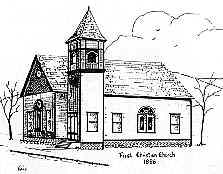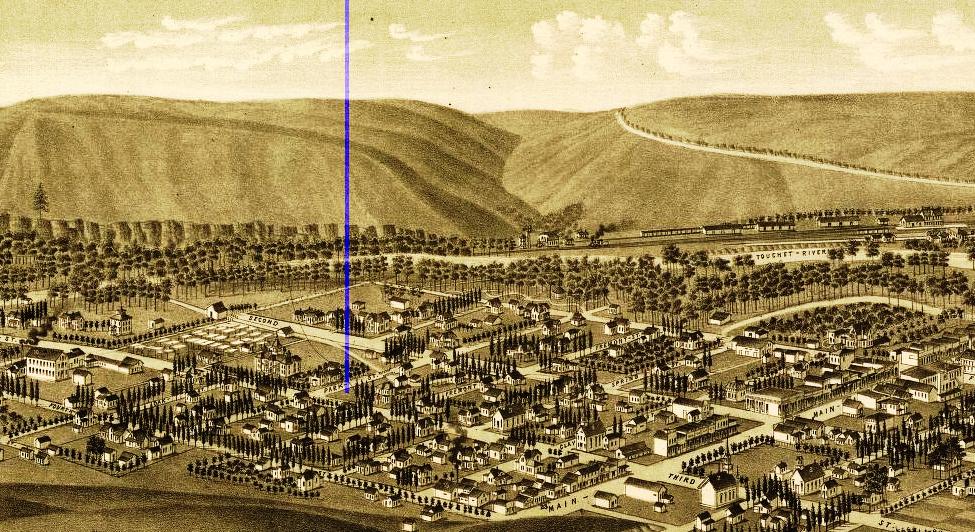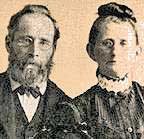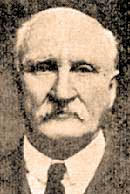 Churches of Christ & Christian Churches in the Pacific Northwest COLUMBIA COUNTY, WASHINGTON |
 by Charles Dailey Main site menu |
Baileysburg | Covello | Dayton | Harmony School
Next Chapter . . . Pioneer Menu . . . Search - - Oldest presented first.
Upper TouchetWhile we do not know the precise location of this town, many of its church members became part of the Dayton Church when it was launched in 1886. The church reported 40 members in 1877 and that it was in healthy condition. The church met at a school house. Supplina Hamilton preached there one time each month. He also preached at Dixie once each month.
Another preacher assisting in these early days was Dr. I. N. Richardson. He preached as a volunteer. Members of the church included Jeremy Bailey, later identified with the Baileysburg Church.
This pioneer congregation has left little record and is difficult to trace. Someone named "C. Wright" reported preaching there once each month during 1877. It was located seven miles east of Dayton. There were 14 members. An elder was J. Donelson.
C. Wright is probably the Charles Wright from what became the Dayton congregation. Check the membership list below for his name. Church planter C. J. Wright did not arrive in Washington Territory until the year following.
The report is in The Christian Messenger, published in Monmouth, Oregon and is dated July 12, 1877.Baileysburg Map
The Baileysburg church came into existence in 1881 and lasted until 1886, when it merged with the Dayton Church. The town is located on the North Touchet River about two miles from Dayton. At first there was a sawmill for the cottonwoods and pines in the area. Then came a furniture factory that built - among other things - church furniture. Some of that furniture is still in use at the Dayton Christian Church.

Jeremy and
Levina BaileyA moving force for industrial development and the Lord's Church was Jeremy Bailey. The decision to merge the stronger Baileysburg church with the new Dayton Church proved to be a correct one. Even the Baileysburg church building was disassembled and moved to Dayton to be part of the new Dayton building.
Dayton Map
The town of Dayton was platted by Jesse N. Day in 1871 and the church was launched 14 years later. We quote from the Centennial History of The First Christian Church:
The history of the Dayton Christian Church is as old as the history of the community in which it exists. When the earliest settlers moved into this area they brought with them the plea for churches patterned after the New Testament example. Before the church was built the individual families lived it and taught it to their children. When schools began to be erected the churches began to crystalize and the number of disciples began to increase. Camp meetings were enjoyed annually at Waitsburg campgrounds and hundreds availed themselves of the fellowship and scriptural preaching.
Thomas M. Morgan
Rachel B. MorganIn 1881 the first actual church organization was perfected at Baileysburg about two miles south of Dayton. The building was erected under the leadership of Thomas McBride Morgan and dedicated by G. W. Richardson.
There is a profile of T. M. Morgan.In the fall of 1885 an organization was begun in Dayton. For some time they met in a little dingy hall on Main Street known as Kuhn's Hall, which was over a downtown store. Brother S. Hamilton of Dixie occasionally preached for them. Early in 1886 J. B. Daisley, an energetic little Scotsman of LeRoy, Pennsylvania, began a series of meetings which culminated in the organization on February 7, 1886 of a First Christian Church of Dayton. There were 40 charter members. The Daisley meetings exceeded all expectations and on March 19 there were a total of 123 members in the church. At that same time the Baileysburg church merged with the Dayton congregation and swelled the membership to 185 names.
S=Sister, B=Brother.
S/Emma Arnold, S/May Dashiell, S/Orpha Dashiell, B/R.L. Dashiell, S/A. Dittimore, S/Barbara Divire, B/Wm. Divire, B/G.F. Drake, S/R.A. Drake, B/E.F. Fish, S/Mary Keeler, S/J.A. Killingsworth, B/John Killingsworth, B/Charles Lawson, B/B.H. Lindsay, S/Mary Lindsay, B/Douglas McGehe, S/Elizabeth McGehe, S/E.L. Maloney, S/Effie Maloney, B/W.H. Maloney, S/L.H. Miller, B/E.B. Moore, S/—Moore, B/B. Morris, S/Mary P. Morris, B/l.N. Muncy, S/Julia Muncy, S/E.J. Musgraves, B/Nathan Musgraves, B/Nathan Musgraves, B/J.N. Richardson, S/Jennie Richardson, B/J.L. Smith, B/Jas. H. Smith, S/A.J. Taylor, B/T.J. Taylor, S/C.D. Wagoner, B/J.B. Ware, S/—Ware, (From Baileysburg:) S/Effa E. Bailey, B/John Bailey, B/Grant Bailey, Jeremiah & Luvirah Bailey, S/Elizabeth Barber, B/Frank Cantril, B/Lee Cantril, S/M.J. Cantril, S/Rosa CantriI, B/Stephen Cantril, S/Jennie Carson, B/J.H. Chasteen, S/M.C. Chasteen, B/John Chenoworth, S/Rebecca Chenoworth, B/Albert Crawford, S/Claronda Crawford, B/M. Cross, B/David Cuppy, S/Matilda Cuppy, S/Sarah Curtis, B/Daniel Davis, S/Isabella Davis, B/Lorenzo Davis, S/Nora Davis, S/Elizabeth Dittimore, B/J.W. Dittimore, S/MariIla Dittimore, B/Theodore Dittimore, B/R. Donley, S/Leonra Donley, S/C.M. Dyer, B/R.F. Dyer, B/VT. Eaton, S/Ettie Eaton, B/Frank Eccles, B/Francis Edmiston, S/Mary F. Edmiston, S/Mary Emery, B/James Grinstead, S/Anna Hatfield, S/Belle Hatley, B/Elijah Hatley, B/Essey Hatley, S/Eva Hatley, S/Hanna Hatley, S/Jane Hatley, B/Jno. Hatley, B/Joseph Hatley, S/Lydia Hatley, B/Lewis Hatley, S/Margie Hatley, S/Millie Hatley, B/Richard Hatley, Willard Hatley, B/Henry Hayton, S/——Hayton, B/E.J. Henderson, S/Sarah Henderson, S/Ellen Hendrix, B/Charles Hensley, S/Cora Hobbs, S/Elzina James, B/J.H. Jenkins, S/N.C. Jenkins, S/Fannie Jenkins, B/H. Keeler, S/Katie Kendall, S/Aldora Kenoyer, B/E.S. Kenoyer, B/Fredrick Kenoyer, S/E.S. Kenoyer, B/Downing Lamb, S/Elizabeth Maxwell Lamb, S/Emma Lindley, S/Susan Lindley, B/Terry Lindley, S/Eva Lord, B/Win. Lord, S/Charity Malone, S/Effie Malone, B/Harrison Malone, B/Lewis Malone, S/Lucinda McCauley, B/Win. McGehe, S/Laura Miller, B/M.B. Miller, Wm. Miller, B/C.E. Mohundro, S/Jane Mohundro, B/Albert Morgan, B/Andrew Morgan, Thomas McBride & Rachel Morgan, S/F. Palmer, B/John Palmer, B/J.W.Peer, S/N.E. Peer, B/Arther Pintler, S/Eliza Pintler, S/Mary Pintler, S/Minnie Pintler, S/Mollie Pintler, B/Alexander Ragan, B/Sidney Ragan, S/Tabitha Ragan, S/Nellie Rainwater, S/A.F. Redford, B/J.B. Redford, Bro. Roberts, S/Helen Ross, B/Chas. Roysdon, S/Hattie Roysdon, S/Mary Roysdon, S/Maranda Savage, S/Iva Shephard, S/Maria Sutlow, B/James Shift, S/Julia Shift, S/Lottie Swinney, B/Jas. N. Taggard, B/John Taggard, B/Homer Taylor, S/Rebecca Tewalt, B/Grant Thayer, S/Clara Tidwell, S/Clara Vaughan, S/Elizabeth Vaughan, S/Nettie Vaughan, S/Susan Ware, B/George Wick, S/Margie Wick, S/Mary J. Wick, S/Mary Williams, S/Ardula Windal, S/—Wood, B/George Wood, B/Charles Wright, B/Charles S. Wright, S/Debora Wright.
Early Ministers:
Underlined names
lead to personal profiles.T. M. Morgan
J. B. Daisley
Neal Cheetham
C. M. Barnes
George Barneby
Craven Peyton Hollis
W. L. McCullough1881 - 1886
1886 - 1889
1889 - 1890
1890 - 1891
1891 - 1894
1894 - 1896
1896 - 1900

Dayton Christian Church - 1886
Sketch by Vivian McCauley
There is a local link to a panorama of Dayton in 1884 showing where the church was located.
The Centennial History continues:
Preparations began immediately for the erection of a building. . . . A fine building, rectangular in shape, similar to the old meeting house design of that era, was built at a cost of $1400. It was dedicated October 17, 1886, the sermon being preached by Brother Holman of Waitsburg. Water from the mill-race that ran behind the site backed up sometimes nearly a foot deep under the edifice. Records described the scene wryly, "The frogs would congregate under the building during the summer evenings, and it was difficult to tell which sang the louder, the people or the frogs."
C. M. Barnes A brief article in the Northwest Tribune of Colfax, Washington, dated November 27, 1890 reports that "last night a fire was set to the (Dayton) Christian Church; while people turned out to quench flames, several houses were burglarised, several persons were caught and are probably guilty of both crimes."
C. M. Barnes was the minister that year. The church has preserved his photo.
Starbuck Map
Starbuck Christian Church The first church in Starbuck was the Presbyterian, built in 1892 at a cost of $3,000. In 1893, General W. H. Starbuck presented a bell to the congregation.
Sometime prior to 1910, the congregation switched from Presbyterian to being a Christian Church. Like nearly every congregation of the time, it grew by having nightly gospel meetings. The Starbuck Signal of 1908 reported that the Christian Church was undergoing repairs preparatory to revival services.
The building was located at the southwest corner of 2nd and Tucanon. It faced the end of Main Street.
The town was once inportant to the railroad because helper engines were added here, but when that was no longer necessary, the town began to decline and some of the buildings were moved to Walla Walla.
Starbuck was named for General W. H. Starbuck, an early railroad financier.
It is remarkable that Orval Peterson did not include this church in his history of the Disciples in Washington State. This group may have been among the four churches that Peterson calls "anti-society," meaning they were not part of the developing missionary society.
The congregation flourished in its earlier years, but the building was vacant by 1930. Eventually the building was dismantled.
Covello Map
John B. Daisley of Scotland arrived in Washington Territory in 1886 and one of his first tasks was to hold a gospel meeting at Covello. From this record, we know about when the church was established. Also, a congregation still existed in 1897.
The town, 14 miles from Dayton, is gone. Farms grew bigger and the number of laborers required diminished. However, a 300 page history remains, but it describes only a Methodist church and, to the writer, it was the only church in town. That building burned in 1910 and was not replaced.Following patterns seen elsewhere, the Christian Church group probably met in a school house or, less likely, a large home.
Next Chapter: Cowlitz County or back to Pioneer Menu
To DOCHS 3/03




